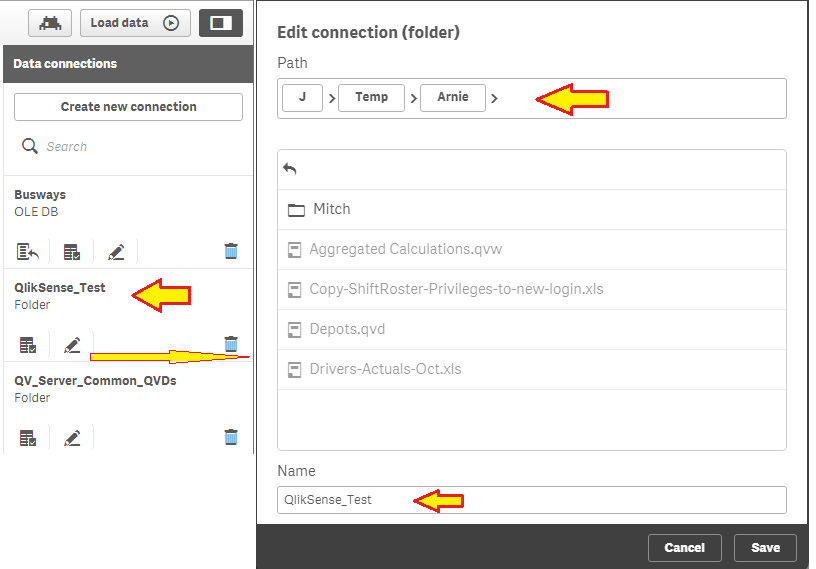Unlock a world of possibilities! Login now and discover the exclusive benefits awaiting you.
- Qlik Community
- :
- Forums
- :
- Analytics
- :
- New to Qlik Analytics
- :
- Re: QLIK SENSE- STORE TABLE INTO TABLE.QVD COMMAN...
- Subscribe to RSS Feed
- Mark Topic as New
- Mark Topic as Read
- Float this Topic for Current User
- Bookmark
- Subscribe
- Mute
- Printer Friendly Page
- Mark as New
- Bookmark
- Subscribe
- Mute
- Subscribe to RSS Feed
- Permalink
- Report Inappropriate Content
QLIK SENSE- STORE TABLE INTO TABLE.QVD COMMAND PROBLEM
My script contains several commands for saving the tables.
At the end of my script After running
store IESIRI into IESIRI.QVD (qvd);
store IESIRI1 into IESIRI1.qvd (qvd);
store NPART INTO NPART.QVD (qvd);
I got the "App successfully saved."
I dont see these qvd files (IESIRI.QVD (qvd) , IESIRI1.qvd , NPART.QVD, etc) not in working directory, not even in the other working directory if I put the directory statement, not anywhere else
According to qliksense documentation site
" If the path is omitted, Qlik Sense stores the file in the directory specified by theDirectory statement. If there is no Directory statement, Qlik Sense stores the file in the working directory, C:\Users\{user}\Documents\Qlik\Sense\Apps.
In Qlik Sense Desktop, the working directory is C:\Users\{user}\Documents\Qlik\Sense\Apps. "
If I do the same commands for testing in QlikView and I have no problem : the qvd files appears where my working directory I put in the script
It is an internal error, something like that, or I do something wrong (wrong command, procedure, etc)
- Mark as New
- Bookmark
- Subscribe
- Mute
- Subscribe to RSS Feed
- Permalink
- Report Inappropriate Content
Hi Daniel,
the documentation refers to the QlikView behavior, where everything is based on a "path". In Qlik Sense, both reading and storing data is based on the Data Connections. With that in mind, I doubt if you can store a QVD and omit the Data Connection name. I think you have to specify the Connection that holds the path to your target folder.
I might be wrong and there might be a "default folder", but I doubt if you want to rely on that and fish for your QVD files from such a strange location. It's a lot better to be explicit and specify the Data Connection
cheers,
Oleg Troyansky
Learn advanced QlikView and Qlik Sense techniques in my book QlikView Your Business
- Mark as New
- Bookmark
- Subscribe
- Mute
- Subscribe to RSS Feed
- Permalink
- Report Inappropriate Content
Thanks Oleg for your answer, btw I bought and I have your book.
Normally in my script I have the Data Connection name as I wrote there is no problem with pulling the data from my source (Oracle database from Internet)
What your saying that even on the saving data I have to specify a the Data Connection name ?
OLEDB CONNECT32 TO [Provider=OraOLEDB.Oracle;Data Source=QV;]
LIB CONNECT TO 'QV'; //CONEXIUNE CU SERVERUL DE ORACLE PE PROTOCOL OLEDB
...................
Directory d:\=STUFF\=Software\Qlik_Sense\QVWs\EVOLUZIONE_WME_ORACLE_SERVER1_BAU; //DE VAZUT UNDE LE SALVEAZA !!!!!
store IESIRI into IESIRI.QVD (qvd);
store NPART INTO NPART.QVD (qvd);
store NART INTO NART.QVD (qvd);
I had tested both with directory statement and without directory command. Same result : I don`t see the qvd files
I had no problem with digging but in what direction ? ( that is a saying in my country)
- Mark as New
- Bookmark
- Subscribe
- Mute
- Subscribe to RSS Feed
- Permalink
- Report Inappropriate Content
For your issue, do follow the below process:
Step 1:
Create folder connection where you will need to save the qvd's
Step 2:
Create a variable and pass the folder connection like below:
SET vExtractedPath = 'lib://Extracted Data Folder (dev_administrator)/';
Where Extracted Data Folder (dev_administrator) is folder Connection.
Step 3:
Call the table like below:
LOAD *
From
[$(vExtractedPath)ABC.qvd](qvd);
- Mark as New
- Bookmark
- Subscribe
- Mute
- Subscribe to RSS Feed
- Permalink
- Report Inappropriate Content
Thanks for your answer , but my problem it is about the store command meaning I don`t see qvd files which I have saved with the script. Your answer is about the load statement
Need help for store command /procedure.
- Mark as New
- Bookmark
- Subscribe
- Mute
- Subscribe to RSS Feed
- Permalink
- Report Inappropriate Content
Hi Daniel,
Ashraf suggestion is in the right track, as it helped me to do what you want to do, I will extend his suggestion:
Step 1:
Create folder connection where you will need to save the qvd's; mine is: QlikSense_Test, it points to the J:\Temp\Arnie folder.

Step 2:
Create a variable and pass the folder connection like below:
NOTE:
I am using the connection name created at step 1.
You may skip step 2 altogether is you do not want to use variables.
SET vExtractedPath = 'lib://QlikSense_Test/';
Step 3:
This is how to store create the QVD using the Folder Data Connection (two options):
- Store [Depots] into lib://QlikSense_Test/Depots.qvd;
- Store [Depots] into $(vExtractedPath)Depots.qvd;
NOTES:
I loaded a Depots table from an Oracle database.
Option 1: without using the variable created on the Step 2.
Option 2: using the variable created at step 2.
Both examples worked for me.
HTH
A journey of a thousand miles begins with a single step.